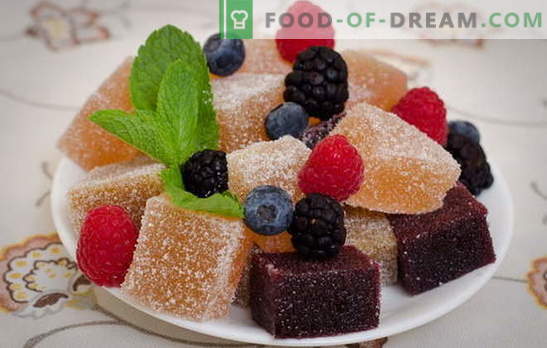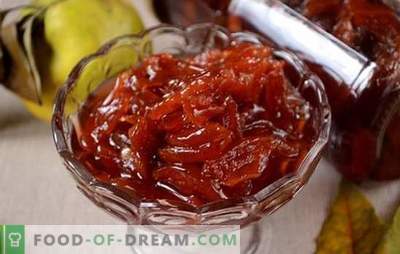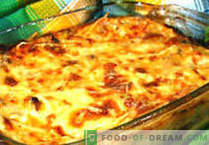
The existence of marmalade in Europe became known in the 14th century.
Moreover, in Portugal, marmalade was considered quince jam, and in France and England, thick, jelly jam was made from citrus fruits.
Later, marmalade began to be prepared from other fruits containing a large amount of pectin, a natural gelling agent.
As a substance, pectin was discovered just over two hundred years ago.
The word “pectin” has Greek roots, which means that the ancient Greeks could have come up with marmalade, considering that Greece is a Mediterranean country with a mild and warm climate, an abundance of citruses, and it was even thousands of years ago.
But the astringent properties of quince, palpable even at first glance, or rather, taste, also indicate the veracity of the Portuguese version of the origin of marmalade. Although quince is a representative of the Middle Eastern flora, as indicated by its name and even astringent taste. But what does Portugal have to do with it? Moreover, this country in the middle of the last millennium, having an excellent fleet, was the main pioneer of new lands, countries, and the most ancient civilizations of the planet. Anyway, medieval Portugal was involved in the discovery of marmalade, although it is clear that it did not do without oriental subtleties.
Marmalade at home - the basic technological principles
In fact, how else could people at the dawn of civilization, without refrigerators and freezers, not knowing the technology of sugar production and canning, save a generous harvest of fruits under the rays of a tropical or even hot sun? There were only two options: drying and boiling the fruit.
At a time when sugar was still very far from the discovery and a little later, when it appeared, but it was a great luxury even for the most distinguished grandees, both in Europe and in Asian countries, people learned to use the gifts of nature to preserve the harvest and make stocks. Everywhere in the role of preservative served honey, fruit juices, which were boiled down to thickening.
Natural components of natural origin and in ancient times and now the most valuable in the manufacture of marmalade. Therefore, marmalade made from sugar is a tasty but not healthy product.
Nowadays, sugar is cheaper than honey, and health is also of the highest value for humans. Therefore, in order not to abandon the marmalade, which manufacturers often produce from cheaper raw materials, using sugar, artificial colors and flavors, lovers of wholesome sweets should better prepare the marmalade at home.
But for this you need to learn some of the subtleties of cooking homemade marmalade.
The greatest amount of pectin required for the preparation of natural marmalade is found in apples, quince, pear, melon, peaches, apricots and plums, cherries and cherries, currants.
For the preparation of high-quality marmalade at home, with sufficient gelling properties and viscous, dense structure, you can use any other fruit juices, but with the addition of pectin powder produced by industry: it is produced from apple cakes, citrus peels and some other natural materials in production.
The main properties of pectin: the powder is slightly soluble in cold water. Its astringent properties are manifested when heated.
The next natural thickener is agar-agar, which is obtained by extracting special algae. The properties of this thickener are similar to pectin.
In addition to pectin and agar for the production of marmalade, the confectionery industry uses gelatin obtained from raw materials of animal origin. Gelatin dissolves at lower temperatures, at 40ºC and higher loses its astringent properties. Low temperatures (from 0ºC) also destroy the collagen contained in gelatin.
These properties of thickeners must be considered when making marmalade at home, as well as other confectionery products. If you are interested in marmalade with extremely beneficial properties, it is advisable to replace sugar with honey, stevia, fructose, or thicken fruit juices without using sugar.
To make marmalade at home look more appetizing and to decorate a dessert table, there are many different methods of its design, but read about it in more detail in the recipes below.
Recipe 1. Marmalade at home from raspberry with pectin
Ingredients:
Raspberries (fresh or frozen) 0.5 kg
Pectin 50 g
Honey (non-sugared) 90 g
Cooking:
Rub the berries through a sieve: you should get 300 ml of juice. It is important to achieve its transparency, so it is desirable to pass the juice through a filter made of several layers of gauze and cotton wool. Heat the juice to 50-60ºC, add pectin to it and bring to the boil in half an hour. Boil for five minutes. Cool to 30-35ºC and, adding honey, mix to completely dissolve the honey. At temperatures above 40ºC, the beneficial properties of honey are significantly reduced, so it is important to add this product to warm juice.
Pour the unheated juice into molds and put it into the cold to set.
Raspberry marmalade with honey, without the use of sugar, can be used as a remedy for colds even to those who are contraindicated in the use of sugar.
Recipe 2. Marmalade at home from the plum
Cooking:
Plums 1.0 kg
Water 300 ml
Sugar 350 g
Pectin (powder) 50 g
Cooking:
Natural clarified juice from plums, without adding water is extremely difficult to obtain. The best variety of plums for juice - Hungarian. Enumerate ripe berries, remove bones. Plums must be steamed. Chop the boiled pulp to puree, and hang in gauze over the capacity into which the juice will flow. Puree shift into a saucepan, cover with water and boil a second time. Combine both parts of the juice, add sugar combined with pectin. When the juice boils, hold on low heat for 10 minutes and pour it warm. You can use the form for candy, cookies. To marmalade was very beautiful and bright, take, apart from Hungary, yellow plums and make a two-layer dessert. For this form, first half fill the marmalade from red plums, and when it hardens, add the yellow marmalade. In this case, start cooking marmalade from yellow plums 3-4 hours later, so that the first layer has time to freeze in the refrigerator.
Recipe 3. Marmalade at home from quince
Ingredients:
Quince 1.5 kg
Treacle 300g
Coconut 100 g
Cooking:
Fruits need to be washed and baked in the oven until soft. When cooled to such a temperature so that it is convenient to work with them further, wipe through a sieve to get mashed pitted and peel. In the resulting puree, add the syrup or sugar syrup, or honey, carefully mixing the mass, put the boil until thickened. During the cooking process, stir continuously and do not forget that for making marmalade it is better to use the same dishes that are usually used for cooking jam or jam.
Spread the cooled mass into molds and sprinkle with coconut chips, which not only decorate homemade marmalade, but also give an interesting taste. If you do not like the taste of coconuts, use sugar.
Recipe 4. Marmalade at home, unsweetened, for snack dishes
Sometimes the marmalade is unsweetened and can be served to different dishes, and not just as a dessert. If you want to arrange a festive snack, jelly or aspic, prepare marmalade from vegetables.
Ingredients:
Beet 0,300 g
Carrots 250 g
Spinach 0.5 kg
Agar 30g
Salt, pepper, sugar
Cooking:
Blanch the spinach and smash it with a blender. Add spices, if needed. Wash the washed root vegetables in foil and bake in the oven until tender. Puree them when they are cold and season with spices, if necessary. Add 10 g of agar to each puree, if necessary, add a little water (for a very thick puree) and let each mass boil. Boil only until the agar is dissolved. Prepare the dishes to mash the mash in a thin layer. You can spread each type of puree separately, or make a three-layer mass. When unsweetened marmalade hardens, cut out figures of the desired shape for decorating dishes.
The use of agar is remarkable in that after cutting the figures, the remaining marmalade trimmings can be collected and reheated again to obtain a liquid mass, and then give it the desired shape.
Recipe 5. Fruit marmalade at home with gooseberry and currant
Ingredients:
Berries of red currant and gooseberry - 1 kg;
Sugar 0.5 kg
Cooking:
Go through the berries, removing the dry buds and stalks, wash them. Berries do not mix, both masses need to be prepared separately. Divide sugar into two equal parts and add each part to the heat-resistant containers with berries. Mash berries slightly and put the containers in the oven preheated to 180ºC for 25-30 minutes. When the berries thicken, remove them and cool to rub through a sieve and remove the cake. Add 100 ml of boiling water to each container, stir and pour the puree from the berries into separate, identical size, shape. The form must first be lined with parchment. Put it in the oven again, but at a temperature of 100-120ºC to evaporate the water. When the juice has a viscous consistency, turn off the oven and slightly open the door, but do not remove the molds until it is completely cooled. If necessary, for drying marmalade, preheat the oven to 50-60ºC two or three times. When the marmalade is ready, sprinkle it with water or syrup. Transfer the marmalade from one form over the other layer, moisten the parchment and remove it. Sprinkle with sugar and let dry. After that, invert the form, in the same way remove the parchment from the bottom layer, again sprinkle the wet surface of the reverse layer with sugar. Cut the finished marmalade into pieces and put in a storage box lined with parchment. Keep such marmalade should be in cool conditions, avoiding high humidity.
Recipe 6. Marmalade at home from orange juice on gelatin
Ingredients:
Juice of red oranges 1.0 l
Fructose 150g
Gelatin 50 g
Cooking:
If you use ready, pasteurized juice, it is only necessary to warm it to dissolve the fructose. Pour about 200 ml of the taken juice into a separate dish, add gelatin into it and heat it in a water bath until completely dissolved. Pour the dissolved gelatin into the total mass of the juice in a thin stream, stirring continuously. Pour the jellied juice into molds and refrigerate for freezing.
Gelatin-based marmalade is best cooked in small quantities so that it can be consumed immediately. Keep it cold, remembering that even at room temperature gelatin begins to “melt”, and the gelatin mass spreads and it is almost impossible to restore the properties of gelatin.
Recipe 7. Marmalade at home “Rainbow”
Ingredients:
Kiwi
Oranges
Coconut milk
Blueberries
Sea buckthorn
Cranberry
Red grapes
Sugar syrup (or molasses)
Agar agar
Cooking:
For multi-colored marmalade, use the juice of fruits of different colors, in the same amount. Add syrup or molasses to each of the juices in a 1: 1 ratio. Agar-agar use in proportion: per 100 ml of juice - 10 g of agar. Prepare the masses for the color dessert separately, alternately: combine the juice with the agar, add the syrup, bring to a boil and pour into a rectangular shape with a high rim. Agar stiffens quickly, so you can immediately begin to prepare the next layer of marmalade. We prepare it in exactly the same way and pour it on the frozen, first layer. We alternate juices in any order: it is important that the layers are bright and contrasting with each other.
You can take more coconut milk to make such marmalade (or replace it with cream), and alternate each layer of fruit marmalade with white marmalade. At the end of the work, cut the frozen layer into pieces.
Marmalade at Home - Tips and Tricks
- Marmalade is a delicious dessert. It can also be a useful dessert, if you avoid excessive consumption of sugar in the cooking process. The main thing to remember is that sugar does not affect the stability of the dense, gelatinized structure of marmalade. Pectin, agar or gelatin form a dense texture, the amount of which can be changed in the recipe, depending on the desired effect.
- To make marmalade an absolutely dietary product, replace sugar with honey. This is easy to do in any recipe. But for this you need to take into account one thing: if you don’t like a very sweet dessert, then the ratio of sugar and honey is about 2: 1, that is, honey must be used two times less than sugar. The reason is simple: honey contains free fructose molecules that affect taste.























